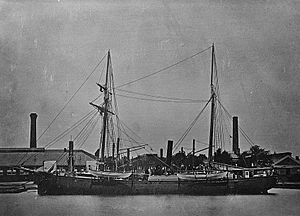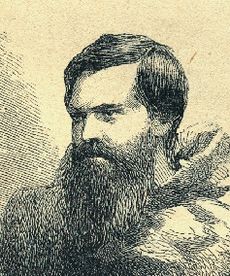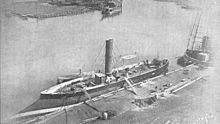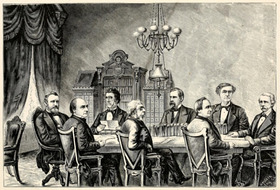George M. Robeson facts for kids
Quick facts for kids
George Robeson
|
|
|---|---|
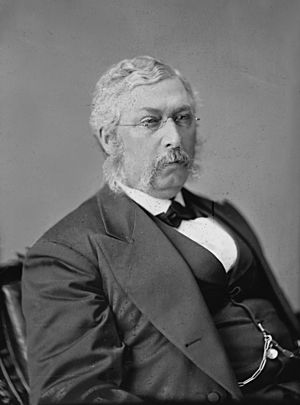 |
|
| Chairman of the House Republican Conference | |
| In office March 4, 1881 – March 3, 1883 |
|
| Speaker | J. Warren Keifer |
| Preceded by | William P. Frye |
| Succeeded by | Joseph G. Cannon |
| Member of the U.S. House of Representatives from New Jersey's 1st district |
|
| In office March 4, 1879 – March 3, 1883 |
|
| Preceded by | Clement Hall Sinnickson |
| Succeeded by | Thomas M. Ferrell |
| 26th United States Secretary of the Navy | |
| In office June 25, 1869 – March 12, 1877 |
|
| President | Ulysses S. Grant |
| Preceded by | Adolph E. Borie |
| Succeeded by | Richard W. Thompson |
| Attorney General of New Jersey | |
| In office 1867–1869 |
|
| Governor | Marcus Lawrence Ward |
| Preceded by | Frederick Frelinghuysen |
| Succeeded by | Robert Gilchrist Jr. |
| Personal details | |
| Born |
George Maxwell Robeson
March 16, 1829 Oxford Furnace, New Jersey, U.S. |
| Died | September 27, 1897 (aged 68) Trenton, New Jersey, U.S. |
| Political party | Republican |
| Education | Princeton University (BA) |
| Military service | |
| Allegiance | |
| Branch/service | |
| Rank | Brigadier General |
| Unit | New Jersey Militia |
| Battles/wars | American Civil War |
George Maxwell Robeson (March 16, 1829 – September 27, 1897) was an important American politician and lawyer from New Jersey. During the American Civil War, he was a brigadier general in the New Jersey Militia. He is best known for serving as the Secretary of the Navy from 1869 to 1877. President Ulysses S. Grant appointed him to this role. Robeson was a member of the Republican Party. After his time as Navy Secretary, he also served two terms as a U.S. Representative for New Jersey from 1879 to 1883.
George Robeson was born in New Jersey and graduated from Princeton University when he was only 18. He then studied law and became a lawyer in 1850. He worked hard and became a public prosecutor for Camden County in 1858. During the American Civil War, he joined the Republican Party. He helped recruit soldiers for the Union Army as a Brigadier General. After the war, in 1867, he became the Attorney General of New Jersey.
In 1869, President Grant chose Robeson to be the Secretary of the Navy. He served for about seven and a half years, which was one of the longest terms in the 1800s. Robeson was a very busy and strong leader. He worked to keep U.S. harbors safe from attacks. He also supported new submarine and torpedo technology. He even got money from Congress for the 1871 Polaris expedition to the North Pole.
Robeson also led an investigation into the mysterious death of Captain Charles Francis Hall from the Polaris expedition. He supported President Grant's Reconstruction laws. These laws helped protect the rights of African Americans. Under Robeson, the U.S. Navy built its first two torpedo warships. He also helped the Navy get ready during a tense time with Spain in 1874. After his time as Secretary, he was elected as a U.S. Representative for New Jersey.
Contents
Early Life and Education
George M. Robeson was born on March 16, 1829. His birthplace was Oxford Furnace, New Jersey, near Belvidere, New Jersey. His family came from Scotland. His grandfather, George C. Maxwell, and his uncle, John Patterson Bryan Maxwell, both served in the U.S. House of Representatives for New Jersey.
Robeson was a very smart student. He graduated from Princeton University in 1847 at the young age of 18. After college, he studied law in Newark, New Jersey. He became a lawyer in 1850. He first practiced law in Newark, then moved his office to Jersey City, New Jersey. In 1858, he became a public prosecutor for Camden County, New Jersey.
Civil War Service
During the American Civil War, George Robeson was appointed a brigadier general in the New Jersey Militia. This appointment was made by the Governor of New Jersey. However, Robeson did not serve in active combat during the war.
New Jersey Attorney General (1867–1869)
Robeson served as the Attorney General of New Jersey from 1867 to 1869. He left this job on June 22, 1869. He resigned because he was chosen to become the United States Secretary of the Navy.
President Ulysses S. Grant appointed George M. Robeson as Secretary of the Navy on June 25, 1869. He replaced Secretary Adolph E. Borie, who had resigned. Robeson officially started his new job on June 26, 1869. This was one of the longest terms for a Naval Secretary in the 1800s. He served until March 12, 1877. This was at the end of President Grant's second term.
Robeson had no experience with building ships before this role. However, he grew up in New Jersey and knew about the ocean. Senator A. G. Cattell of New Jersey helped him get the job. Robeson was about 40 years old when he became Secretary. He was known as a strong and energetic leader.
Congress did not always approve money for new ships. So, Robeson used money meant for repairing old ships to build new ones. He would use new materials but keep the old ship names. He often made the ships bigger and replaced wood with iron. Some people criticized him for this. However, a navy historian said his actions were "proper and advisable" during a crisis.
The Polaris Expedition (1871)
Secretary Robeson ordered the Polaris expedition. This was the first serious attempt by the United States to reach the North Pole. On June 29, 1871, USS Polaris sailed from New York. Captain Charles Francis Hall led the expedition. Robeson and Hall had convinced Congress to pay for the trip.
Robeson gave clear instructions for the mission. He planned for two and a half years. He ordered that anything found would belong to the U.S. Government. Records were to be kept, and food supplies hidden along the way. The Polaris had all the scientific tools needed for such a dangerous trip.
The Polaris set a record for sailing farthest north at 82°29'N. In October 1871, the crew set up a winter camp. They planned to reach the North Pole by dogsled. On October 24, Captain Hall became very sick after drinking coffee. Later, it was believed he was poisoned. Two weeks later, Captain Hall died. Sidney O. Buddington took over the expedition.
Under Buddington, the expedition became less organized. On June 2, 1872, after failing to reach the North Pole, the ship turned back. The ship got stuck in ice. Nineteen crew members were separated on an ice floe. They floated 1,800 miles before being rescued. The remaining crew wintered off Greenland. They were rescued by a whaling ship in June 1873.
When the crew returned, Robeson immediately started an investigation. He looked into Hall's death and Buddington's leadership. Captain Hall's journals were missing or damaged. The investigation did not charge anyone with Hall's murder. However, in 1968, Hall's body was examined. Scientists found he had been poisoned with arsenic. It is now believed that Emil Bessels, who was in charge of Hall's medical care, likely murdered him. Robeson's final report said Hall died a "natural" death. Captain Hall had named Robeson Channel in honor of Secretary Robeson before his death.
Submarine and Torpedo Testing (1869–1875)

During Robeson's time, the U.S. Navy tested new submarine and torpedo technologies. The Intelligent Whale was an experimental submarine. It was hand-cranked and had been tested in 1866. In 1869, Robeson's committee recommended buying it. Robeson signed a contract to buy the submarine for $50,000. However, the testing was delayed. In 1872, the ship was officially tested by the Navy. It took on water because of a faulty seal. Even though it failed, it showed the Navy's interest in new weapons. The first submarine bought by the U.S. Navy was Alligator in 1863.
Testing torpedoes was more successful. In July 1869, Robeson created the United States Naval Torpedo Station. It was on Goat Island in Newport, Rhode Island. The goal was to find cheap and effective underwater weapons. This included testing torpedoes, explosives, and electrical equipment. Robeson wanted them to make a self-propelled "Fish" torpedo. This was based on the Whitehead torpedo from England.
Robeson said the torpedo needed to go underwater for a long distance. It also needed to be fast and stay on a straight course. The torpedo was about 12+1⁄2 feet (3.8 m) long and weighed 480 pounds (220 kg). It carried 70–90 pounds (32–41 kg) of explosives. It could travel 300–400 yards (270–370 m). Compressed air powered its propeller. Early tests worked, but there were some problems with leaks.
In 1872, John L. Lay's remote-control torpedo was successfully tested. This torpedo testing in the 1870s helped create modern American underwater warfare. In 1873 and 1874, USS Alarm and USS Intrepid were launched. They were equipped with spar and projectile torpedoes. By 1875, all U.S. naval cruisers had these torpedoes. Naval officers were trained to use them. USS Intrepid was the first U.S. steam-powered projectile torpedo ship.
Centennial Exposition Land (1873)
On July 4, 1873, Robeson dedicated land for the 1876 Centennial Exposition. This was a big event to celebrate 100 years of American independence. President Grant could not attend, so he sent Robeson in his place. The Centennial Exposition opened on May 10, 1876.
The Virginius Incident and War Crisis (1873)
On October 31, 1873, a Spanish warship captured the Virginius. This was a U.S. merchant ship that was secretly carrying weapons and soldiers to help Cuba fight for independence from Spain. News spread that 53 British and American citizens from the Virginius were shot by Spanish authorities. Many Americans were very angry and wanted war with Spain.
On November 14, 1873, President Grant ordered the Navy to prepare for war. Robeson sent U.S. warships to Key West, Florida, which is close to Cuba. However, the U.S. Navy was not as modern as the Spanish Navy. One U.S. officer said that two Spanish warships could have easily defeated the American fleet.
During this crisis, Secretary Robeson decided the Navy needed to be stronger. He wanted to build monitor warships that could compete with foreign navies. Congress did not want to build new ships. So, Robeson and Congress agreed to "rebuild" five of the biggest U.S. warships. These ships were taken apart and rebuilt with new iron materials. Work started in 1874. Congress, however, did not give Robeson enough money to finish them. The incident showed that the U.S. Navy needed to be modernized.
New Warships Ordered (1874)
Because of the Virginius Incident, Secretary Robeson ordered five new warships on June 23, 1874. These ships were rebuilt from older designs. They included the USS Puritan, the USS Amphitrite, the USS Monadnock, the USS Terror, and the USS Miantonomoh. All these ships later served in the Spanish–American War in 1898.
For example, USS Terror captured three Spanish warships in April 1898. USS Puritan attacked Matanzas, Cuba. USS Miantonomoh helped blockade the coast of Cuba. USS Amphitrite shelled San Juan, Puerto Rico. USS Monadnock fought in the Battle of Caloocan in the Philippines.
On December 6, 1875, Secretary Robeson released a report on the U.S. Navy. The New York Times reported that the Navy was "stronger than at any time" since the American Civil War. Robeson stated that the Navy had 147 ships. Eighty of these ships were ready for war. This included sixteen ironclads and two torpedo ships: USS Alarm and USS Intrepid. USS Intrepid was the second U.S. propelled torpedo warship. The British Royal Navy did not have a similar ship until 10 years later.
Robeson also mentioned that the Navy was using new types of guns. Gatling guns were on every ship. The Torpedo School was developing powerful torpedoes. He asked Congress for more money to finish the five new warships he had ordered in 1874.
Congressional Investigations (1876)
In 1876, a Congressional investigation looked into Secretary Robeson's finances. It was found that he had deposited a lot of money into his bank account. This was much more than his yearly salary. Robeson cooperated with the committee. The investigation found that a company had received a large naval contract. There were suggestions of improper payments. However, there was no direct proof linking Robeson to these payments.
The committee's report criticized Robeson's management. It suggested that he might be impeached. However, no impeachment charges were ever made against him. President Grant supported Robeson and did not ask him to resign.
Defended by President Grant (1876)
On December 5, 1876, President Grant defended Robeson in his annual speech to Congress. Grant said that the Navy was not as modern as European navies. But he added that Robeson had done his best with the money and power given to him. Grant said that because of Robeson's work, the U.S. Navy was "more powerful and effective than it ever has been in time of peace."
Grant also asked Congress for more money to finish the five modernized warships that Robeson had ordered in 1874. He explained that building new ships with steam power was very expensive.
U.S. Congress Representative (1879–1883)
In 1878, Robeson was elected to the U.S. Congress. He served as a U.S. Congressman for New Jersey's 1st congressional district. His first term was from March 4, 1879, to March 3, 1881. He was elected for a second term, serving from March 4, 1881, to March 3, 1883.
During this time, the U.S. Navy made big improvements. It started building all-steel ships. In the 1882 election, Robeson lost to Democrat Thomas M. Ferrell. After this loss, Robeson moved to Trenton. He started a new law practice there. In 1881, Robeson also tried to become a U.S. Senator for New Jersey but was not successful.
Death
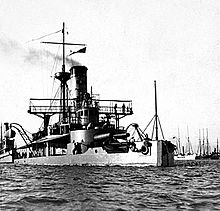
George Robeson continued to practice law until he died at age 68 on September 27, 1897. He is buried at Belvidere Cemetery in Belvidere, New Jersey. Less than a year after his death, the five warships he had ordered in 1874 played important roles in the Spanish–American War, which began in April 1898.
Family Life
On January 23, 1872, George Robeson married Mary Isabella (Ogston) Aulick. She was a widow with a son named Richmond Aulick. George and Mary had a daughter named Ethel Maxwell Robeson. Ethel later married William Sterling in England in 1910. Mary's son, Richmond, graduated from Princeton University in 1889.
After his political career ended, Robeson faced some personal challenges. He moved to Trenton and continued his law practice. He lived a simpler life until his death.


